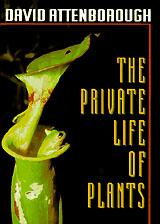
Sex and the single spruce
|
This review first appeared in the American Reporter in 1995.
So you think human mating patterns are weird, eh? Singles bars full of polyester-clad Lotharios and personal ads seeking the perfect Aries and all the other things we do to find a sexual partner?
Well, maybe we are a bit odd, especially if one considers the mating behaviors of Michael Jackson and Madonna, but reading David Attenborough's "The Private Life of Plants" makes clear that when it comes to sexual behavior, we don't have anything on plants. In fact, kinky as we can sometimes be, we don't use other species to complete the sex acts with our partners (or, at least, we don't need to use other species ...).
But many plants, particularly flowering land plants, depend on insects, birds and small mammals to transport their reproductive cells from one individual to another, to complete the process of fertilization.
If you find it amusing the way balding middle-aged men grow their hair long on one side then flip it over their domes in order to attract the female of our species, then you'll love the way the mirror orchid grows flowers that resemble a female bee to attract a male bee – so that he'll carry the orchid's pollen off to the orchid's potential mates. Or the way the bucket orchid makes a bee swim through its nectar in order to dust the bee with pollen before allowing it to escape – taking the fertilizing pollen with it.
These and other oddities Attenborough explores in delightful detail and dry British humor in the companion to his PBS television series of the same name. Oh, sure, not every chapter is dedicated to sex. There are chapters devoted to survival, to traveling plants, to feeding and growing.
But ultimately, all of these issues come down to life's basic function – which is to reproduce ourselves (which is, for most species, sex). And it's here that Attenborough has his most fun, pointing out how some fungi spread their spores briefly after living most of their lives underground. Or as to how some species cannot scatter their seeds until their seed pods have been opened by a brush or forest fire.
Like his earlier books (which also accompanied PBS series) "The Living Planet," "Life on Earth" and "Trials of Life," "The Secret Life of Plants" is wonderfully illustrated with color photographs equal to anything in National Geographic. As mentioned, Attenborough brings a certain humor to his writing that livens it considerably beyond what most scientific books offer – even popular science books.
Most of all, though, Attenborough brings a joyous sense of wonder to the world of nature – and we are the beneficiaries of his insatiable curiosity.

